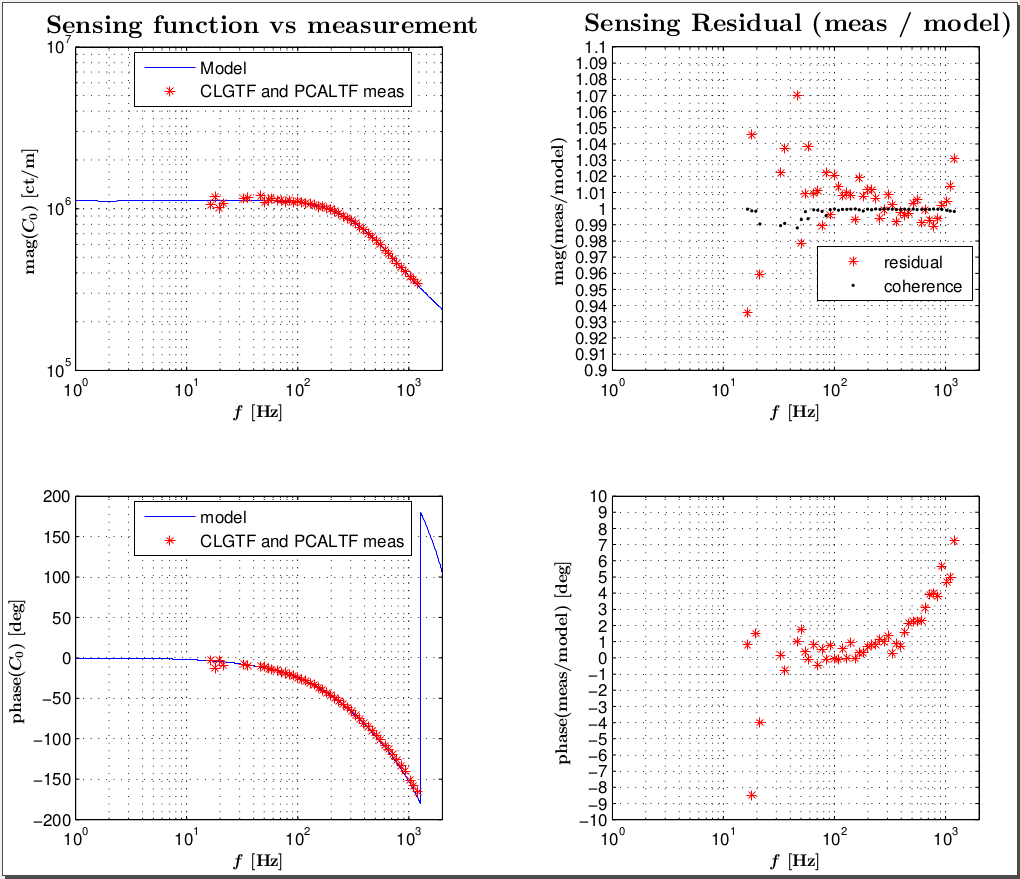Jeffrey K, Kiwamu I, Darkhan T
Summary
We implemented most of the analysis results from recent calibration measurements into the H1 DARM OLGTF model for ER8/O1 (see details below). Sensing, actuation and the digital filters' TF models that make up a DARM OLG TF model are used for calculating the interferometer strain h(t), tracking and possibly correcting temporal variations in the DARM parameters.
The comparison of the H1 DARM OLGTF model vs. a DARM OLGTF measurement taken on 2015-08-30 07:19:40 UTC gave a residual of about +/- 3% in magnitude and +/- 10 degrees in phase [~30, ~500] Hz.

The measurements of a DARM OLGTF and a PCALY to DARMTF that we used for estimating the parameters of the model were taken within the same lock stretch (LHO alog 21023). The sensing function obtained from combining both of these TF measurements gave a residual of under +/- 4% in magnitude and under +/- 8 degrees in phase when compared to the DARM OLGTF model in the frequency range of [~20, ~1100] Hz. We see an unresolved trend in the phase of the sensing function residual.

Details
This model is based on the earlier version of this script, that has been described in LHO alog 20819, however earlier model agreed with the DARM OLGTF measurements to a lesser degree: about +/-10% in magnitude and +/-5 degree in phase up to 200 Hz.
Below we list major improvements / changes to the DARM OLGTF model that were implemented since then (if one needs to track changes all the way from ER7 model, he/she can check LHO alog 20819 for the list of prevous changes).
-
DC drive levels [N/ct] for each of the suspension stages are now calculated from a set of calibrated factors.
- For UIM and PUM drivers the following factors were given in the parameter file: V_dac / dac_ct, V_ai / A_coil, N_sus / A_coil and an euler matrix factor;
- For ESD driver the following factors were given: V_dac / dac_ct, alpha_NpV^2, low and high voltage gain (slope), esdBiasSign, an euler matrix factor.
- Now model supports correction for imperfect compensation of frequency dependencies of ESD and coil driver in the driver output filters.
Calibration team at LHO managed to take large number of measurements that were used for estimation of parameters of the actuation function, see LHO alogs 20846, 21023. Over the last two weeks calibration team analyzed these measurements (see LHO alogs 21015, 21142, 21189, 21232, 21283). As a result we adapted the DARM OLGTF model to be able to handle a set of zero-pole TFs that differ for each of the quadrants of the drivers. Implementing these helped to significantly reduce the residual between the model and the measurement.
- Kiwamu worked on analyzing DARM OLGTF and PCAL to DARM TF measurements to estimate parameters of the sensing function (see LHO alog 21023). By LISO fitting he found that the coupled-cavity pole frequency of the interferometer is around 330 Hz.
- OMC DCPD signal chain analysis showed that a zero-pole set of DCPD signal chain fitted to a measurement differ from the set used in the DARM model for ER7 (see LHO alog 21126). These additional poles were added into parameter files of the ER8 DARMOLGTF measurements.
We are planning to work more on looking for sources of inaccuracies of the DARM OLGTF model.
The development is underway on separating OMC DCPD frequency dependencies for two of the DCPDs. In the existing DARM OLGTF model it's assumed that both of the DCPDs have the same zeros and poles, which, according to LHO alog 21126, is not entirely true, and could potentially introduce systematic errors.
The model was uploaded to calibration SVN:
CalSVN/aligocalibration/trunk/Runs/ER8/H1/Scripts/DARMOLGTFs/H1DARMOLGTFmodel_ER8.m (r1341)
The parameter file associated with the measurement from Aug 30 2015 07:19:40 UTC (GPS: 1124954397) is in the same directory:
CalSVN/aligocalibration/trunk/Runs/ER8/H1/Scripts/DARMOLGTFs/H1DARMparams_1124954397.m (r1339)
Plots produced by this model were committed to SVN into:
CalSVN/aligocalibration/trunk/Runs/ER8/H1/Results/DARMOLGTFs/2015-09-08_H1DARM_*.pdf
CalSVN/aligocalibration/trunk/Runs/ER8/H1/Results/DARMOLGTFs/2015-09-08_H1DARM_*.eps


